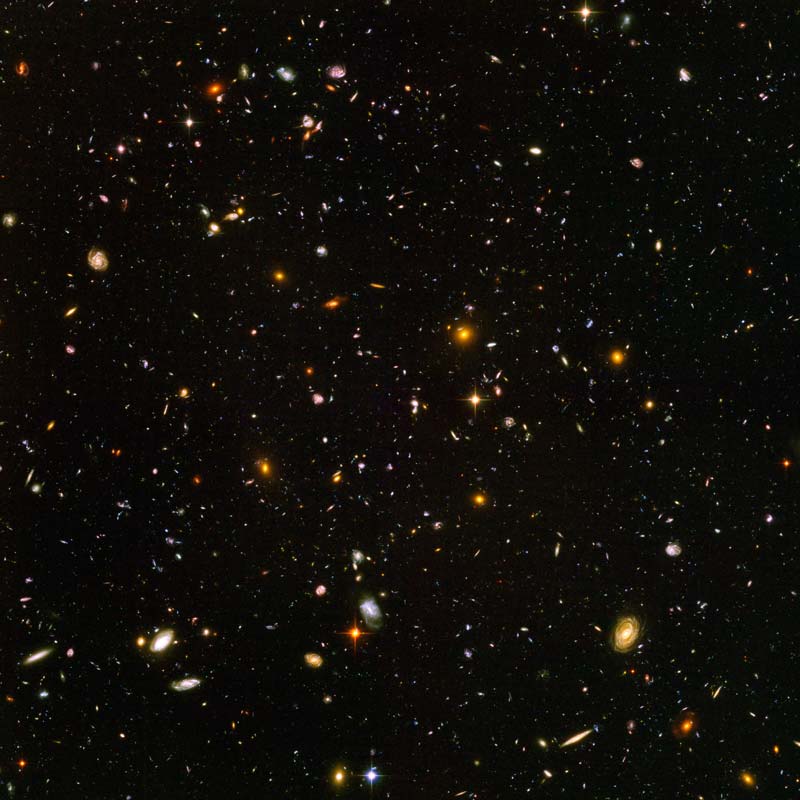







| BOOKS | F. A. Q. | ARTICLES | TALKS | ABOUT KEN | DONATE | BEYOND OUR KEN |
|---|
By Ken Croswell
Published on ScientificAmerican.com (July 31, 2012)

Beyond Hubble: Not even the Hubble Space Telescope can crack the mystery of the universe's reionization. Credit: NASA, ESA, S. Beckwith and the HUDF Team (STScI), and B. Mobasher (STScI)
In the beginning, there was light—the brilliant light of the big bang, shining through a sea of protons, neutrons, and electrons. But as the universe expanded and cooled, the electrons joined the protons, making neutral hydrogen atoms, and as the universe cooled further, the light went dark. Eventually, however, something tore the electrons from the protons, thereby reionizing the universe. Space has remained ionized—a plasma of positive ions and electrons—ever since. Now an upcoming paper proposes the surprising cause: runaway stars flung from their galactic birthplaces.
"Reionization was one of the major cataclysmic events in the history of the universe," says Charlie Conroy, an astronomer at the University of California, Santa Cruz. Yet because reionization occurred so long ago, even the greatest telescopes struggle to probe this distant epoch. Observations of the farthest quasars as well as the big bang's afterglow indicate that reionization took place sometime between a redshift of 6 and 12, a measure of astronomical distance that corresponds to the time when the universe was only 380 million to 960 million years old. But exactly what caused this great transformation is a mystery.
The culprit must have been something hot, because only hot objects emit extreme ultraviolet light, whose wavelength is less than 912 angstroms and whose photons are so energetic they rip electrons from protons. Quasars once seemed a logical bet, because they are hot and bright and existed long ago. But astronomers have failed to find enough quasars at great distances to do the job.
So the focus has turned instead to hot stars. Trouble is, these stars presumably lived in galaxies filled with neutral hydrogen gas—which absorbs extreme ultraviolet light.
"Of all the ionizing photons that hot stars are producing in today's galaxies, only about a percent of the photons actually leave the galaxy," Conroy says. "Those ionizing photons are being wasted in the galaxy."
Now, in work to appear in the August 20, 2012, issue of The Astrophysical Journal, Conroy and Kaitlin Kratter of the Harvard-Smithsonian Center for Astrophysics propose a resolution to this dilemma. They say that hot stellar runaways—stars shot out of their nurseries—may have reionized the early universe.
Stars born with the most mass—more than 16 times that of the Sun—are so hot that astronomers classify them as spectral type O. These O-type stars glow blue and emit most of their radiation at ultraviolet wavelengths, then explode just a few million years after birth. In our own Galaxy, the Milky Way, about 30 percent of them are runaway stars. One famous example, visible to the naked eye, is the star Mu Columbae, which is fleeing its birthplace in the constellation Orion and now resides in another constellation altogether.
A runaway star can make its escape when one star orbiting another explodes, freeing its partner at high speed. Runaways also emerge from star clusters, where gravitational encounters among stars fling some of the members away.
Our Galaxy is so huge, with a disk more than 100,000 light-years across, that runaway O-type stars don't escape it during their short lives. In the early universe, however, galaxies were much smaller. During the epoch of reionization, they may have been just a few hundred light-years across. "If a star is traveling at a high velocity, it can actually leave the parent galaxy," Kratter says. Then the star's extreme ultraviolet light shines into the space beyond the galaxy. As a result, Conroy says, "These stars could be a very important player in the reionization of the universe."
"It seems like a viable hypothesis that these runaway stars can contribute significantly to the ionizing radiation," says Brian Siana of the University of California, Riverside. "But the question is: are they the dominant factor?" Siana says supernova explosions may have punched holes in the gas of the first galaxies, producing a Swiss cheese–like structure that allowed extreme ultraviolet radiation from hot stars to seep out of the galaxies, obviating the need for runaways.
Conroy and Kratter suggest a way to test their idea. Astronomers can't see individual stars at the great distances corresponding to the epoch of reionization. But if hot stars escaped the first galaxies, the galaxies themselves should look larger at wavelengths where they emitted ultraviolet light than at longer wavelengths, because the hot, ultraviolet-bright runaway stars had fled their homes. Seeing such distant galaxies is too tough a task even for the Hubble Space Telescope, but Conroy and Kratter say that 30-meter ground-based telescopes planned for the future should find them, shedding new light on the universe's ancient metamorphosis.
Ken Croswell earned his Ph.D. in astronomy from Harvard University and is the author of The Alchemy of the Heavens and The Lives of Stars.
"An engaging account of the continuing discovery of our Galaxy...wonderful." --Owen Gingerich, The New York Times Book Review. See all reviews of The Alchemy of the Heavens here.
"A stellar picture of what we know or guess about those distant lights."--Kirkus. See all reviews of The Lives of Stars here.
| BOOKS | F. A. Q. | ARTICLES | TALKS | ABOUT KEN | DONATE | BEYOND OUR KEN |
|---|